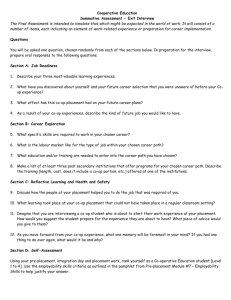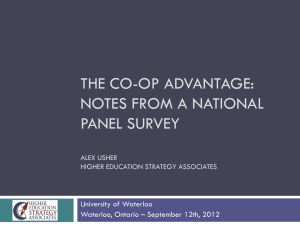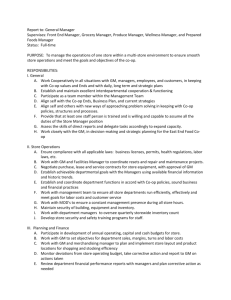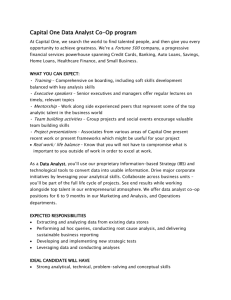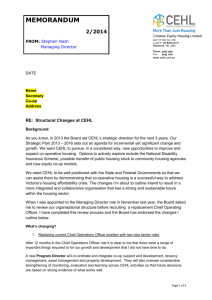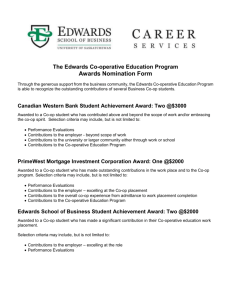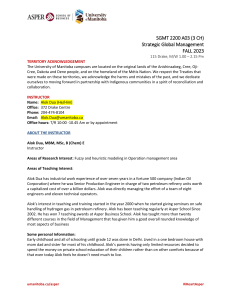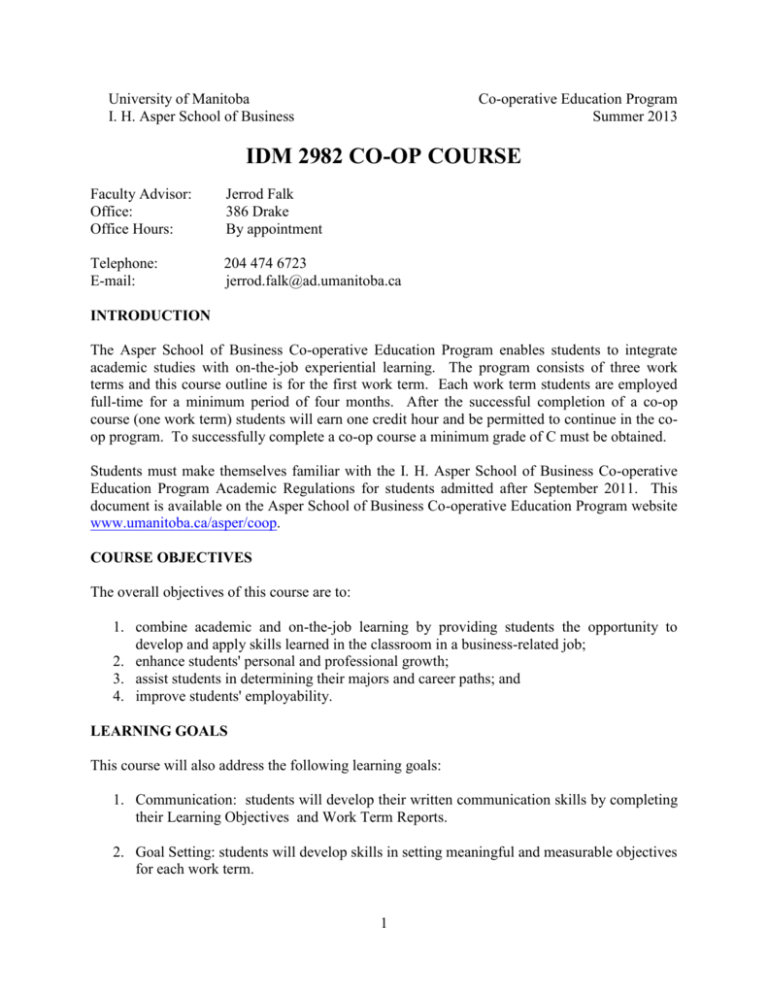
University of Manitoba
I. H. Asper School of Business
Co-operative Education Program
Summer 2013
IDM 2982 CO-OP COURSE
Faculty Advisor:
Office:
Office Hours:
Jerrod Falk
386 Drake
By appointment
Telephone:
E-mail:
204 474 6723
jerrod.falk@ad.umanitoba.ca
INTRODUCTION
The Asper School of Business Co-operative Education Program enables students to integrate
academic studies with on-the-job experiential learning. The program consists of three work
terms and this course outline is for the first work term. Each work term students are employed
full-time for a minimum period of four months. After the successful completion of a co-op
course (one work term) students will earn one credit hour and be permitted to continue in the coop program. To successfully complete a co-op course a minimum grade of C must be obtained.
Students must make themselves familiar with the I. H. Asper School of Business Co-operative
Education Program Academic Regulations for students admitted after September 2011. This
document is available on the Asper School of Business Co-operative Education Program website
www.umanitoba.ca/asper/coop.
COURSE OBJECTIVES
The overall objectives of this course are to:
1. combine academic and on-the-job learning by providing students the opportunity to
develop and apply skills learned in the classroom in a business-related job;
2. enhance students' personal and professional growth;
3. assist students in determining their majors and career paths; and
4. improve students' employability.
LEARNING GOALS
This course will also address the following learning goals:
1. Communication: students will develop their written communication skills by completing
their Learning Objectives and Work Term Reports.
2. Goal Setting: students will develop skills in setting meaningful and measurable objectives
for each work term.
1
3. Critical Thinking: students will be expected to apply concepts learned in the classroom
to on-the-job situations.
4. Self Evaluation and Reflection: students will be expected to reflect on and communicate:
what they learned from their work experience;
whether they were able to achieve their learning objectives; and
how their work experience will affect their future endeavors on academic,
professional and personal levels.
MARK ALLOCATION
Learning Objectives Report, due May 27, 2013
Work Term Report, due Sept 20, 2013
25%
75%
100%
The final grade of a report submitted after the due date will be reduced by 5% of the
maximum grade of the report.
Students earning a grade of less than 60% on either the Learning Objectives Report or Work
Term Report will be required to redo/revise their report. The revised report must be submitted
within five working days of the date the request for a redo was communicated. The maximum
final grade of the revised report is 60%.
Students will be awarded a letter grade for each co-op course based on the following scale:
Numeric Grade
90% - 100%
80% - 89.9%
75% - 79.9%
70% - 74.9%
65% - 69.9%
60% - 64.9%
50% - 59.9%
0% - 49.9%
Letter Grade
A+
A
B+
B
C+
C
D
F
Students achieving a grade of less than C in any co-op course will be required to withdraw from
the program.
2
LEARNING OBJECTIVES REPORT
Since one of the objectives of the course is to combine academic and on-the-job learning,
students are required to set learning objectives for the work term. The learning objectives will
describe the measurable goals that students aspire to achieve during their work term.
The learning objectives should be meaningful to the student and relevant to his/her job and
career aspirations. Learning objectives should be developed after the first one or two weeks of
employment - once details of the job are known. While forming learning objectives students
should take into account the specific responsibilities of their job, their job supervisor's goals for
the student, as well as their personal strengths and weaknesses, past job experiences, and
knowledge obtained through courses. The learning objectives should be reviewed and approved
by the student's supervisor on the job.
The learning objectives should be SMART:
specific
measurable
agreed upon
realistic
timely
A specific learning objective clearly states what the goal is, for example, "I will improve my
written communication skills as evidenced by the weekly reports I prepare". "I will improve
my communication skills" is too vague.
A measurable learning objective offers criteria for measuring progress towards the goal, for
example, "I will improve my written communication skills by preparing weekly reports that
require no editing by my manager before they are passed on to the management team". The
learning objective specifically indicates how the student will know the learning objective has
been met and also specifically indicates who will measure the success of meeting the
learning objective.
An agreed upon learning objective will be meaningful to both the student and the job
supervisor.
Realistic learning objectives are achievable given the job responsibilities, experience,
knowledge and temperament of the student. Goals should be high enough to require a
reasonable degree of effort to ensure substantial learning takes place during the work term.
Learning objectives must include a time frame indicating when the goals should be
accomplished.
The learning objectives report should include four to six goals incorporating hard skills goals,
soft skills goals and task based goals. Hard skills are technical skills, such as auditing
procedures and software applications. Soft skills include personal skills such as work habits,
3
communication skills and analytical skills. Task based goals include the completion of jobrelated tasks, such as the completion of a marketing survey.
The report must be completed in MS Word format. The cover page of the report must include:
the title "Learning Objectives Work Term One"
student name
student ID number
phone number
email address
major (if known)
date
employer
position
The body of the report (excluding the cover page) must be double-spaced in 12-point font size,
include one-inch margins, page numbers, and consist of 500 to 750 words in good sentence
form. Reports falling outside this range of word count will not be read but returned to the
student to be revised. The maximum final grade of the revised report is 60%.
The following headings must be included in the report:
Introduction
Hard Skills Goals
Soft Skills Goals
Task Based Goals
The introduction should include a brief description of the student's job responsibilities (two
to three sentences should be sufficient).
The learning objectives report will be evaluated on both content and written communication
skills. The rubric that will be used to evaluate the report is available on the Asper School of
Business Co-operative Education Program website www.umanitoba.ca/asper/coop.
WORK TERM REPORT
The work term report should show what was learned from the work experience and how Asper
courses benefitted the work experience. The report is intended to be an honest, reflective, and
structured review of the work term experience.
The report must be completed in MS Word format. The cover page of the report must include:
the title "Work Term One Report"
student name
student ID number
email address
4
The body of the report (excluding the cover page) must be double-spaced in 12-point font size,
include one-inch margins, page numbers, and consist of 1,300 to 1,500 words in good sentence
form. Reports falling outside this range of word count will not be read but returned to the
student to be revised. The maximum final grade of the revised report is 60%.
The following headings must be included in the report:
Introduction
The Job
The Learning Objectives
The Position and Fit
The Learning
Conclusion
The content under each heading must be specific. For example, stating "the company was a
great place to work" is not adequate. Indicate what made it "great", for example, "the company
provided a respectful and helpful environment, where all employees were motivated to help one
another".
In the Introduction provide a brief description of the job and the company. Summarize the key
points contributing to whether the job was a good experience (or not) given your major,
experience, temperament and education. The introduction should be concise, no more than three
to five sentences.
In The Job describe your job title and duties. Do not include lengthy descriptions of how these
duties were completed. For example, it is appropriate to state "one of my responsibilities was to
complete the monthly bank reconciliations". Do not continue by stating how this was completed,
for example "I obtained the bank statement information online, and I matched each cheque on
the bank statement to the company's cheque register ..."
Some points to reflect on in this section include:
did the tasks you were asked to perform give you a broader understanding of your major?
were your tasks the tasks you expected to perform? If not, was this a good or
disappointing experience? Why?
were your duties and tasks well explained to you? Explain your conclusion. Any
suggestions for improvement?
did you find the job easy to adjust to? Why or why not?
did you get along well with your supervisor and co-workers? Why or why not? What, if
needed, could be done to improve these relations?
Under The Learning Objectives you are expected to reflect on whether or not you met all of
your learning objectives. Reflection must be made on each specific learning objective identified
in your learning objectives report. It is not sufficient to state "I met all my learning objectives".
5
Points to consider for each learning objective include:
was the learning objective met? Why or why not?
what actions did you undertake to attempt to reach your objective?
how did the assigned job and training contribute (or not) to your success?
how did your experience, education and temperament contribute (or not) to your success?
was the learning objective appropriate and realistic? Why or why not?
how can you better identify learning objectives for the next work term?
Marks are not awarded based on whether or not you met all your learning objectives. You will
be graded on the quality of your reflection and analysis of the goal setting process and why you
were successful (or not) in achieving your goals.
In The Position and Fit you are expected to discuss how well your work term experience
meshed with your major and your expectations for the work term. Points to consider include:
did the work term experience contribute to your understanding of your planned career
path? Why or why not?
what, if anything, should be done to ensure a better fit between the job and your major?
what, if anything, could your employer have done more to enrich your work experience?
what, if anything, could you have done more to enrich your work experience?
did the work term experience affirm your planned career path or are you now considering
a new career path? Why?
In The Learning you are expected to summarize what you have learned during your work term
experience. Points to consider include:
what did you learn that specifically relates to your major?
what did you learn that does not specifically relate to your major but you consider to be
useful?
which courses were most helpful in your work term? Specify how each course was
beneficial.
do you think what you learned on the job will enrich your classroom education? How?
Be specific.
did you learn anything new about yourself? If you did, how will this affect your future
actions in the classroom and work place?
The Conclusion should include a brief description of the impact your participation in the co-op
program has had on you personally, academically and professionally.
The work term report will be evaluated on both content and written communication skills. The
rubric that will be used to evaluate the report is available on the Asper School of Business Cooperative Education Program website www.umanitoba.ca/asper/coop.
6
UPLOADING THE REPORTS
To Upload Learning Objectives:
Log on to the Career Portal at https://asper-umanitoba-csm.symplicity.com/students. You
will have previously received your username and password from the Co-op Office. If
you did not receive this email, please email the Co-op Office immediately – DO NOT
create a new username and password.
From the home page, click ‘Profile’. Complete your personal and academic profiles, then
select ‘Your Co-op Work Terms’. When you see the appropriate work term, select
‘Edit’.
Complete the ‘Work Term Contact Info and Learning Objectives’ form.
Email your completed Learning Objectives to the Co-op Office at
aspercoop@umanitoba.ca.
Above instructions must be completed by the deadline outlined by the Co-op Office.
To Upload Work Term Report:
Log on to the Career Portal at https://asper-umanitoba-csm.symplicity.com/students. You
will have previously received your username and password from the Co-op Office. If
you did not receive this email, please email the Co-op Office immediately – DO NOT
create a new username and password.
From the home page, click ‘Profile’. Complete your personal and academic profiles, then
select ‘Your Co-op Work Terms’. When you see the appropriate work term, select
‘Edit’.
You must complete three forms – 1. ‘Self-Evaluation Survey’, 2. ‘Work Term Evaluation
Survey’, and 3. ‘Work Term Report’.
Above instructions must be completed by the deadline outlined by the Co-op Office.
ACADEMIC INTEGRITY
Students must become familiar with the faculty’s policy on academic integrity noted on page 13
of this course outline, particularly with respect to plagiarism.
The typical penalty for a first-time offence includes an F in the course with a notation on the
transcript and being barred from taking any courses in the I. H. Asper School of Business for a
period of six to eight months.
PROFESSIONAL WRITING TIPS
It is expected that students prepare both reports in a professional tone using correct grammar,
spelling, punctuation and word usage. Good resources available to students include:
content from the Business Communications course (GMGT 2010) or Introduction to
Communications course (GMGT 2000).
the Writing section of the Virtual Learning Commons Web site at:
http://www.umanitoba.ca/virtuallearningcommons/heading/6
7
grammar-checking and spell-checking functions of MS Word, keeping in mind that these
functions do not catch all errors.
the CA School of Business Communication and Critical Thinking Guide April 2012
available at:
http://www. casb.com/Portals/0/documents/currentstudents/guides/
CommunicationCriticalThinkingGuide.pdf
Excerpts from the guide follow:
Word Usage1
Advice/Advise
o “Advice”: noun, a recommendation (Example: “The client sought her advice.”)
o “Advise”: verb, to give advice (Example: “She advised the client on tax rates.”)
Affect/Effect
o “Affect”: verb, to influence (Example: “The news affected my innermost
senses.”)
o “Effect”: as a noun, a result (Example: “That was the desired effect.”)
o “Effect”: as a verb, to cause or produce (Example: “He hoped to effect change.”)
Among/Between
o “Between” introduces two terms and “among” introduces more than two terms
(Example: “She has to choose among three main courses and between two
desserts.”)
Assure/Ensure/Insure
o “Assure”: to give confidence; to inform positively (Example: “I assure you we
can finish the work tonight.”)
o “Ensure”: to make sure of (Example: “Please ensure you turn off the lights.”)
o “Insure”: to secure against a loss (Example: “I insure my bike against theft.”)
Because/As/Since
o To express an unequivocal reason or cause, use “because” instead of “as” or
“since”. (Proper example: “She was very excited because her vacation started in
two weeks.” Poor usage examples: “She was very excited as her vacation started
in two weeks”; “she was very excited since her vacation started in two weeks.”)
CAs/CA’s
o “CAs”: plural, more than one CA (Example: “CAs provide tax advice.”)
o “CA’s”: possessive form of CA (Example: “The CA’s computer was broken.”)
1
Courtesy of CA School of Business. CA School of Business Communication and Critical Thinking Guide April
2012, pages 10 - 12. Copyright 2012 – CA School of Business. All rights reserved. Materials herein may be
reproduced within the context of professional practice or classroom education, provided that reproduced materials
are not in any way directly offered for sale or profit.
8
e.g./i.e.
o “e.g.”: for example (Example:”Identify significant balance sheet accounts, e.g.
accounts receivable, inventory, and accounts payable.”)
o “i.e.”: that is; in other words (Example: “The equity accounts, i.e. share capital,
contributed surplus, and retained earnings, are on the balance sheet.”)
If/Whether
o “If”: indicates a condition, choice, or concession (Examples: “If the client does
this, the result will be ... If not, the result will be ...”)
o “Whether”: indicates a choice between two or more circumstances (Example: The
client must decide whether to invest in the company.”)
Its/It’s
o “Its”: possessive form of it (Example: “The firm improved its competitive
position.”)
o “It’s”: contraction of “it is” or “it has”; used in casual communications (Example:
“It’s expected to rain.”) In professional writing, do not use this contraction.
Fewer/Less
o Use “fewer” with nouns that can be counted. (Example: “There are fewer errors
than expected.”)
o Use “less” with nouns that cannot be counted (Example: “He felt less fear.”)
Loose/Lose
o Loose: adjective – slack, opposite of tight (Example: “The company has loose
internal controls.”)
o Lose: verb – miss, opposite of win (Example: “I always lose my keys.”)
More than/Over
o More than: use “more than” when you can quantify the amount (Example: “That
cat weighs more than 15 pounds.”)
o Over: “over” is a spatial relationship (Example: “My hand is over the table.”)
Principal/Principle
o Principal: adjective – major, primary, leading; or noun – head of a school, leader,
high-level individual, owner (Adjective example: “Tania’s principal objective is
to achieve business growth”; noun example: “Tania is the principal of Mogen
Flowers.”)
o Principle: noun, fundamental law, rule, or theory (Example: “Accounting methods
often rely on the cost principle.”)
9
That/Which
o Use “that” with restrictive clauses, needed for the sentence to make sense.
(Example: “The cat went through the door that was red.”)
o Use “which” with non-restrictive clauses, not required for the sentence to make
sense. (Example: “The door, which was red, was open.”)
Who/Whom/That
o “Who”: object and person (Example: “The partner who is in charge of audit met
with the client.”)
o “Whom”: indirect object and person (Example: “The client to whom the letter was
addressed met with the partner.”)
o “That”: things, organizations, and groups (Example: “The letter that was sent to
the client identified the major recommendations.”)
Hyphenation2
Use hyphens for most compound modifiers (e.g. tax-free distribution and lump-sum
payment).
Close up compound words and prefixed words wherever possible, except where a double
vowel is created (e.g. pro-active, pre-existing).
Hyphenate words with “related” and “specific” when used as modifiers (e.g. companyrelated data, client-specific requirements).
Pronouns3
o Use “his or her,” “himself or herself,” and “he and she” when referring to one
person whose gender could be male or female, do not use “their,” “themselves,”
or “them.”
o Use “it or its” and not “they, them, or their” when referring to a company or other
organization.
2
Courtesy of CA School of Business. CA School of Business Communication and Critical Thinking Guide April
2012, page 12. Copyright 2012 – CA School of Business. All rights reserved. Materials herein may be reproduced
within the context of professional practice or classroom education, provided that reproduced materials are not in any
way directly offered for sale or profit.
3
Courtesy of CA School of Business. CA School of Business Communication and Critical Thinking Guide April
2012, page 12. Copyright 2012 – CA School of Business. All rights reserved. Materials herein may be reproduced
within the context of professional practice or classroom education, provided that reproduced materials are not in any
way directly offered for sale or profit.
10
Examples of Unprofessional vs. Professional Tone4
Unprofessional:
Professional:
Sales increased by a whopping 80%.
Sales increased by 80%.
You can’t take a deduction for...
You cannot take a deduction for...
Be sure to keep in mind that...
Note that... (Or, for conciseness, delete the
phrase)
The importance of this issue cannot be
overrated.
You need to be able to look at both
sides of the coin.
This issue is important because...
This approach has advantages and
disadvantages.
I’ve gone over your question...
I have analyzed...
I do believe that taking the deduction
now would be more beneficial...
Taking the deduction now would be
more beneficial because...
The accountant completely forgot to...
The accountant did not...
4
Courtesy of CA School of Business. CA School of Business Communication and Critical Thinking Guide April
2012, pages 19 to 20. Copyright 2012 – CA School of Business. All rights reserved. Materials herein may be
reproduced within the context of professional practice or classroom education, provided that reproduced materials
are not in any way directly offered for sale or profit.
11
MORE GRAMMAR AND SPELLING TIPS
1. Structure your sentences properly.
Avoid run-on sentences (two complete sentences joined together).
Avoid sentence fragments (a group of words that have no subject or verb and express an
incomplete thought).
Make sure you use both commas and conjunctions properly when joining complete sentences or
ideas together.
Poor Structure: I managed a number of projects. Most notably a communication plan and a
marketing strategy.
Good Structure: I managed a number of projects, most notably a communication plan and a
marketing strategy.
2. Use clear and precise vocabulary.
Choose your words carefully. Avoid vague or ambiguous language - be direct and clear. Avoid
informal language such as slang, unnecessary abbreviations and clichés. Being too colloquial or
too overblown (e.g. awesome, outstanding, etc.) is also not acceptable for formal business
communication. Use of phrases such as "You'll get a kick out of this!" is also not acceptable.
Poor vocabulary: I went to a workshop on fundraising.
Good vocabulary: I participated in a workshop on fundraising.
3. Ensure there is agreement between the subject and the verb.
Check your sentences carefully to make sure that plural subjects agree with plural verbs and
singular subjects agree with singular verbs.
Lack of agreement: The administrator in charge of all other staff members are eager to share
in the workload.
Good agreement: The administrator in charge of all other staff members is eager to share in
the workload.
12
4. Maintain parallelism.
Use the same format for words in a series, sequence or list. This means using the same word
type (adjective, verb, noun, etc.) and the same verb tense if possible.
Poor parallelism: My duties included planning meetings, scheduling events, and I arranged
several fundraisers.
Good parallelism: My duties included planning meetings, scheduling events and arranging
several fundraisers.
5. Punctuate correctly.
Make sure to check for missing or incorrect punctuation, such as absent apostrophes or
misplaced semicolons. Consult a grammar handbook if necessary.
Poor punctuation: On my supervisor's recommendation; I tried a new strategy.
Good punctuation: On my supervisor's recommendations, I tried a new strategy.
6. Eliminate homophone errors.
Pay attention to words that sound the same but have different spellings and meanings, especially
common errors, such as "it's/its", "they're/their/there" and "you're/your". Homophone mistakes
will not be caught by the spelling or grammar checking function in a word processor.
Homophone error: I updated the database and increased it's efficiency.
No homophone error: I updated the database and increased its efficiency.
7. Do not use contractions.
Never contract two words.
Contraction: It's ready to be submitted to the president.
No contraction: It is ready to be submitted to the president.
13
Academic Integrity
It is critical to the reputation of the I. H. Asper School of Business and of our degrees, that
everyone associated with our faculty behaves with the highest academic integrity. As the faculty
that helps create business and government leaders, we have a special obligation to ensure that our
ethical standards are beyond reproach. Any dishonesty in our academic transactions violates this
trust. The University of Manitoba Undergraduate Calendar addresses the issue of academic
dishonesty under the heading “Plagiarism and Cheating.” Specifically, acts of academic
dishonesty include, but are not limited to:
using the exact words of a published or unpublished author without quotation marks and
without referencing the source of these words
duplicating a table, graph or diagram, in whole or in part, without referencing the source
paraphrasing the conceptual framework, research design, interpretation, or any other
ideas of another person, whether written or verbal (e.g., personal communications, ideas
from a verbal presentation) without referencing the source
copying the answers of another student in any test, examination, or take-home assignment
providing answers to another student in any test, examination, or take-home assignment
taking any unauthorized materials into an examination or term test (crib notes)
impersonating another student or allowing another person to impersonate oneself for the
purpose of submitting academic work or writing any test or examination
stealing or mutilating library materials
accessing tests prior to the time and date of the sitting
changing name or answer(s) on a test after that test has been graded and returned
submitting the same paper or portions thereof for more than one assignment, without
discussions with the instructors involved.
Group Projects and Group Work
Many courses in the I. H. Asper School of Business require group projects. Students should be
aware that group projects are subject to the same rules regarding academic dishonesty. Because of
the unique nature of group projects, all group members should exercise special care to insure that
the group project does not violate the policy on Academic Integrity. Should a violation occur,
group members are jointly accountable unless the violation can be attributed to a specific
individual(s).
Some courses, while not requiring group projects, encourage students to work together in groups
(or at least do not prohibit it) before submitting individual assignments. Students are encouraged
to discuss this issue as it relates to academic integrity with their instructor to avoid violating this
policy.
In the I. H. Asper School of Business, all suspected cases of academic dishonesty are passed to the
Dean’s office in order to ensure consistency of treatment.
14

